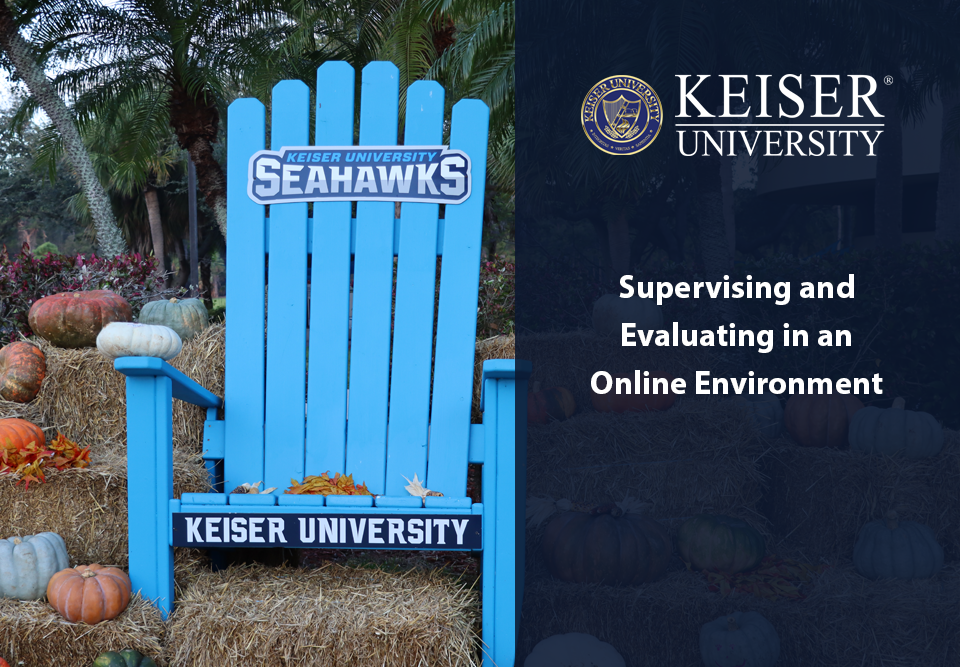Educators are no strangers to the concepts of supervision and evaluation. Teachers at all levels who have been instructing students inside classrooms are familiar with the experience of having their principal or administrator sit in on their class and evaluate their performance and effectiveness as a teacher.
However, the models of supervision and evaluation have had to shift in the digital age. As online learning becomes more common, educational leaders have had to produce innovative ways to enact online supervision in a way that is both fair and effective.
What Is Online Education Evaluation and Supervision?
Sometimes referred to as e-supervision, online supervision and evaluation is defined as the process of monitoring teachers who are educating students in the digital realm and providing them with effective feedback that will help them grow as educators. According to Vosaic, evaluating online learning requires administrators to blend traditional approaches with the latest technology, allowing online teachers to receive valuable, evidence-based feedback regarding their performance and effectiveness as teachers.
Evolution of Online Education
From the time the Internet was invented, educators and administrators have been figuring out how to leverage technology to improve learning outcomes. In recent years, however, online education has evolved swiftly and rapidly. Today, modern learners of all ages, stages and skill levels can effectively navigate online learning platforms and educational technology, proving that online learning is now the norm rather than the exception.
Differences Between Online and Traditional Supervision
While the purpose of supervision and evaluation remains the same, whether it is being performed traditionally or online, there are key differences to keep in mind:
- Online supervision takes place remotely.
- Online supervision typically relies on advanced technology, data collection and algorithms.
- Online supervision focuses on a teacher’s effectiveness within the virtual classroom environment.
Differences Between Online and Traditional Evaluation
Both online and traditional evaluations refer to the effectiveness of an educator within the classroom setting, but these are the key differences to keep in mind regarding online evaluations:
- Online evaluations refer to data collected during supervision.
- Online evaluations may impact career growth and mobility.
- Online evaluations may occur more frequently, as they are easier and more affordable to complete.
Understanding Online Evaluation and Supervision
As the educational landscape changed and evolved over the past several decades, it became clear that there was a need for online evaluation and supervision in the virtual classroom setting. Understanding the role that online evaluation and supervision plays can help educators and administrators improve the process in the years to come.
Setting the Standards for Online Supervision
The key to effective online supervision is transparency. Administrators need to be honest and upfront about the online supervision practices that will be implemented and the technology that will be used to complete the evaluation. Some standards for online supervision may include:
- Utilizing safe and secure technology to complete the online supervision process.
- Identifying the time, place and frequency of the supervisory stage.
- Clearly stating the data that will be collected and the goals for online supervision.
Supervisor’s Role in Online Supervision
Even though the supervisor will be conducting the online supervision remotely, they still play a critical role in the process. A supervisor or administrator will be responsible for implementing the technology and ensuring that it is used properly to conduct a fair and effective evaluation.
Identifying the Needs of Online Learners
Recognizing the needs and goals of online learners can enhance online supervision experience. Administrators need to be aware of the unique needs of online learners to effectively monitor, evaluate and assess the educators managing a virtual classroom.
The top needs of online learners include:
- Affordable programming.
- Efficient learning experiences.
- Flexible learning environments.
- Intuitive and effective technology.
- Synchronous and asynchronous learning opportunities.
Aspects of Evaluation and Supervision in Online Education
There are multiple factors to keep in mind when conducting online supervision and evaluation in any learning environment. Knowing the various aspects involved in evaluation and supervision in online education can help you more fairly and effectively assess the teachers who work for you.
Role of Supervisors in Virtual Classrooms
While supervisors can easily step into physical classrooms just to monitor progress and evaluate the atmosphere in the learning environment, it can be a little more challenging to evaluate the learning environment in a virtual classroom. That said, supervisors still play an important role in molding the online learning environment. Supervisors can and should rely on the latest educational technology to monitor teachers who are teaching in virtual classrooms. Supervision plays a vital role in online learning quality assurance, and effective supervision ensures that all students are receiving a valuable education.
Ensuring Academic Integrity Online
Ensuring academic integrity online is one of the top priorities of administrators and educators who specialize in virtual classroom management. School leaders can actively work to promote academic integrity in the online learning environment by:
- Developing positive working relationships with teachers to create a sense of trust in the online learning environment. Prioritizing relationships in the virtual classroom is one of the best ways to prevent academic dishonesty.
- Utilizing online tools to verify the accuracy and integrity of the work. For example, supervisors can use plagiarism checkers to scan submitted work and see if there are any similarities between the student’s work and the work that exists in the online realm.
- Outlining clear consequences for academic dishonesty in hopes of preventing students from resorting to those measures instead of completing their own work.
Monitoring Student Progress
In addition to evaluating the performance of teachers in the virtual classroom setting, supervisors and administrators can also evaluate student progress. In a way, monitoring student data and evaluating progress in the classroom is another way of evaluating the educator’s effectiveness in the virtual classroom. When student outcomes are positive, it can be assumed that the teacher is performing well in their digital classroom.
Strategies for Effective Online Supervision
Two of the most effective strategies for online supervision include:
- Asynchronous supervision — This strategy requires the supervisor to evaluate a pre-recorded lesson. In this case, the supervisor can take the time needed to evaluate the learning environment and assess the teacher’s approach during the lesson.
- Synchronous supervision — This strategy allows the supervisor to witness online learning in real-time. During synchronous online supervision, the supervisor or administrator joins the classroom as a participant and can observe in a similar manner to a traditional, in-person observation.
Evaluating Online Learning and Teaching
Supervisors and administrators must recognize that they need to take a different approach to evaluating online learning and teaching. This is largely because the needs of online students are different, and the online learning experience is distinctly separate from the traditional learning experience in a classroom. Knowing how to effectively evaluate online learning and teaching will make you a more intuitive administrator in today’s ever-changing educational landscape.
Criteria for Assessing Online Courses
These are some of the criteria that should be used to assess online courses:
- A clearly outlined course syllabus.
- Identifiable learning objectives within each lesson of the course.
- Tools and resources available for students to successfully complete the course.
- Fair and effective online assessments within the course.
- Engaging lessons that promote positive student outcomes.
- Instructional design that promotes accessibility and fairness among all learners in the classroom.
Tools and Techniques for Online Evaluation
The flexibility and versatility of online learning opens many new avenues for online evaluation. Some of the best tools and techniques for online assessment and evaluation include:
- Online interviews
- Simulations
- Online quizzes
- Question-and-answer sessions
- Peer evaluations
Gathering Student Feedback in a Digital Environment
Student feedback is critical to any online evaluation, as their experiences can lend valuable insight into the style and effectiveness of the online instructor. Supervisors and administrators can work to gather student feedback in a digital environment by engaging students in discussion within the virtual classroom. This gives students a survey to complete or asks them to participate in a panel where they can offer more information about their own learning experiences with that instructor.
Best Practices for Online Education Evaluation and Supervision
Remote teaching evaluation is becoming more common with each passing year, and as a result, there are always new and improved best practices for online education evaluation and supervision to consider. Supervisors and administrators should consider the online learning environment offered at their facility as well as the latest technology available as they adopt the best practices for online learning quality assurance.
Implementing Regular Check-ins with Instructors
While formal observation and evaluation is expected, administrators can improve the results of their supervision by regularly checking in with all instructors managing virtual classrooms. Regular check-ins give educators and administrators a chance to casually discuss challenges and successes in virtual learning, adding valuable context to formal evaluations.
Setting Expectations and Goals
Before starting an online observation and evaluation, you should be transparent with the teacher about your expectations and goals. By establishing your expectations for what they can do in the online learning environment and being honest about your goals for that individual instructor, you can create a more positive atmosphere that lends itself to constructive feedback and professional growth.
Providing Continuous Professional Development
Evaluating your instructors and providing them with constructive feedback is not enough. You need to actively work to provide them with opportunities to improve their virtual classroom management skills. Offering insightful and relevant professional development courses will allow your instructors to develop the specific skills needed to effectively teach in an online learning environment, while simultaneously helping your instructors feel valued and appreciated. By investing in your educators, you are showing them that you value their contributions and their dedication to their students.
Promoting a Culture of Feedback and Reflection
Accepting feedback can be hard, particularly when an educator has devoted a significant amount of time and energy to crafting lessons for their virtual classroom. As an administrator, you can help ease the discomfort associated with constructive feedback by cultivating a culture of reflection within your educational facility. You should actively work to solicit feedback from educators and students about their own experiences as part of that learning environment, including their experiences with you as an administrator. By welcoming feedback about your own performance and reflecting on your progress as an educational leader, you can help your educators feel more comfortable assessing their own professional growth and development.
Developing Comprehensive Evaluation Plans
Prior to beginning the online supervision and evaluation process, you should develop comprehensive evaluation plans that outline the steps you will take, the criteria you are looking for and the format in which the evaluation will be provided. Not only will this guide the process, but it also increases transparency and improves trust among your educators.
Explore the Top Virtual Classroom Management Strategies at Keiser University Graduate School
Virtual learning is no longer the exception — it has become the norm in classrooms at all levels of education across the country and around the world. Many educators are beginning to learn how to build upon their traditional educational foundation and explore the best virtual classroom management strategies, making now an excellent time to consider a graduate degree from Keiser University Graduate School.
At Keiser University, we offer a wide range of graduate degree programs in education, including a Master of Science in Education, Teaching and Learning, a Master of Science in Education, Instructional Design and Technology, a Doctor of Education and a Doctor of Philosophy in Curriculum and Instruction.
Request more information about our graduate degree programs today.






 The instructors at Keiser University impacted my life. They believed in my ability to become a great graphic designer, regardless of how I felt about my skills. KU helped to prepare me for the real world and got me to where I am today.
The instructors at Keiser University impacted my life. They believed in my ability to become a great graphic designer, regardless of how I felt about my skills. KU helped to prepare me for the real world and got me to where I am today.
